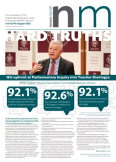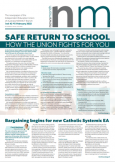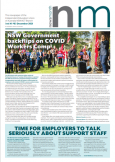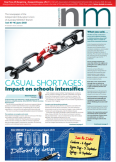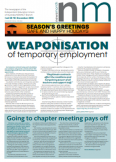
CEO of The Parenthood Georgie Dent
It got to the point where “the office lady said to me, ‘Look, I think you need a plan B. It’s not going to happen’,” Sam says.
Sam is one of many school teachers around the country struggling with the inaccessibility of childcare in rural and regional communities. According to an August study by Victoria University, 700,000 Australians have virtually no access to childcare.
Researchers mapped the country’s ‘childcare deserts’ – areas with more than three children per childcare place. They found that 24 per cent of the population live in a childcare desert, with most of these falling in regional or remote parts of Australia.
The teacher shortage in the early education and care (ECEC) sector is having a knock-on effect on teachers in primary and secondary schools.
The Parenthood, which advocates for affordable early childhood education for all Australians, consistently hears from teachers and principals struggling to get care for their children, says CEO Georgie Dent.
The difficulty in securing childcare is causing some school teachers to delay or modify their return to the classroom, an experience Dent says The Parenthood hears about regularly.
The economic burden
For Sam, not being able to get care meant she couldn’t return to teaching three days a week, as planned.
“My husband and I had to sit down and have a really serious and emotional conversation about just what we were going to do and what was financially possible for us,” the first-time mother says.
Sam’s husband makes a little less than her and he drives to the next town for work. The cost of fuel was another financial strain. They decided Sam would work full time and her husband would stay home with their son.
“It’s honestly been tough for us,” Sam says. “You know, if we were given the opportunity, we would swap in a heartbeat.”
While she loves her job and is grateful her husband has had the time to bond with their son, Sam wishes she’d had a choice in her child’s care.
Living on one income is tough for the young family. “You know I wouldn’t say we’re thriving by any means, but we’re surviving,” she says.
According to a September report from The Parenthood, 86 per cent of regional, rural and remote parents surveyed are experiencing financial difficulties because they can’t get the childcare they need.
A shared experience
Sam knows she’s not alone in dealing with the economic hardships, emotional stress and work pressure of being unable to access care.
“This isn’t just an experience that I’m having as a first-time mother, it’s an experience every woman in this town and across the state in rural areas, is having with every child,” she says.
Like Sam, fellow-IEU member and teacher Liz struggled to find childcare in time for her return to work. “Most people I know, and it’s generally the women, don’t return to work in the capacity that they need to because they don’t have the care,” says the mother of three.
Liz had accepted a full-time role as a teacher and subject coordinator at a Catholic school in the large country town where she lives.
Having put her children’s names down for 10 different centres far in advance, Liz thought she’d be fine. With no places available, she managed to find a spot at a different daycare centre she hadn’t heard about. But Liz soon learned why they were the only available centre around.
She went by the daycare early one day to find her daughter “strapped into a pram screaming two metres away from a TV, which is incredibly distressing”, Liz says.
She reported the centre and pulled her children out, but she was once again without care.
Liz’s husband travels for work and she has no familial support. She hired a nanny, at a huge expense, while she called all the centres as often as she could.
From the time she first put her childrens’ names down, Liz waited almost two years for a spot for her three children. “And you know, it’s like that for a lot of people,” she says.
Communities left behind
It’s been over three years since Liz moved to the town, and in that time, four childcare centres have been built, she says. “But the problem is, they’ve built them, and they can’t staff them, so rooms aren’t opening”.
The supply of early childhood education and care places around the country has increased by about 70,000 since 2020, says Associate Professor Peter Hurley, the lead author of Victoria University’s study. Childcare is more accessible, but “it’s still grown in the places that already had relatively high levels of childcare, mostly metropolitan areas,” he says.
While more needs to be done to invest in the ECEC sector, the government is taking important steps to recognise the value of such “a critical workforce”, says Dent (see box below).
Shining a light
Both Sam and Liz feel there isn’t enough awareness of the impact the childcare shortage is having on essential workers in country towns. They want to see more dialogue, more action from politicians, and more understanding from employers.
When Sam’s son was eight weeks old, her employer began calling, asking what days Sam would return to work. She was empathetic with her school’s need to plan, but in the wait for childcare, she simply didn’t have the information they needed.
“I found that really tough to be fielding phone calls and feeling like I was letting them down because I was unable to give them answers,” says Sam.
Teaching in a childcare crisis is proving too much for some, with the stress of balancing pick-ups, drop-offs, school hours and the inaccessibility of care, says Liz. “I know so many people who are leaving the profession because of the challenges.”
For Sam, there are no easy answers to the childcare shortage in rural and regional Australia, but she’s grateful to have a forum to talk about the impact on teachers like her.
She believes greater awareness will make a difference. “So, I think just bringing this up is hopefully going to create more understanding.”
* Last names and locations have been withheld to protect privacy.














































































